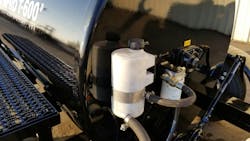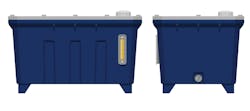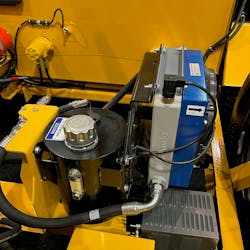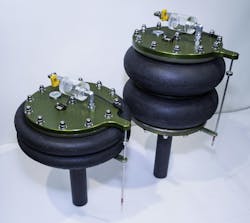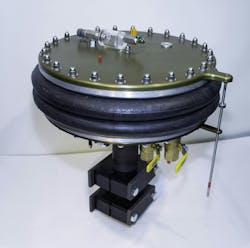Hydraulic Reservoirs: Is it Time to Rethink Their Size?
Hydraulic reservoirs have traditionally been large in size to mitigate heat buildup and prevent air from getting into hydraulic oil, both of which can cause performance issues. However, the weight, size and cost associated with using large hydraulic reservoirs can present challenges.
“They might be great for reducing air and increasing efficiency, but they add complexity and cost,” said Marcus Herrera, Application Engineer, Advanced Systems Team, HYDAC International during a presentation he gave as part of the National Fluid Power Association’s (NFPA) June 2024 quarterly technology conference.
Re-evaluating the size of hydraulic reservoirs, also referred to as a tank, can help to overcome these challenges as use of a smaller reservoir makes it possible to reduce the amount of materials and oil required, leading to cost and weight savings.
Why Larger Hydraulic Reservoirs Have Been the Rule of Thumb
The status quo in the hydraulics industry for many years has been to use a large hydraulic oil reservoir. There are several reasons for this, including the need to supply enough oil for components such as hydraulic cylinders and mitigating thermal expansion — when oil gets warm, it expands and so space is needed to accommodate this.
Herrera said there are also some common thoughts in the industry as to why more oil, and thus a larger reservoir, is better. One is that the more oil that is in the reservoir the cooler it will be as hot oil running through a machine can negatively impact performance.
Another common thought is that the longer oil sits in the tank (referred to as dwell time), the less air there will be going into the hydraulic system which can be detrimental to its performance. Herrera said air in the system is just like any other contaminant as it can cause increases in temperature and noise, change oil viscosity and more.
He said historically to keep air out of the system the mentality was to use a good tank design which meant using the rules of thumb that were always used:
- lowering the tank turnover rate to increase dwell time
- include baffles to prevent sloshing
- placement of the return and suction lines – don’t put them next to or pointed at one another.
However, all of this has led to the creation of larger hydraulic reservoirs which may not be the best option from a size, weight and cost perspective.
Smaller Hydraulic Tanks Offer Several Benefits
Moving away from the larger sized hydraulic oil reservoirs commonly used in machines can offer a range of benefits.
Operational and production costs can be lowered when using a smaller reservoir due to the reduction of steel, plastics and oil used in the manufacture and use of a tank — benefitting end-use customers and the manufacturers producing and installing them. Using fewer materials aids sustainability efforts as well.
As Tom Price, President, Price Engineering, a SunSource Company, noted in an interview with Power & Motion, oil is not getting any cheaper. High quality oils and biodegradable options are expensive as well. Smaller reservoirs such as Price Engineering’s Cyclone Hydraulic Reservoir reduce the fluid volume and space required for oil, leading to cost savings of sometimes several hundreds of dollars he said which can greatly benefit a machine owner’s bottom line.
Less oil in the reservoir means harmful environmental impacts are minimized as well should a leak occur. Hydraulic oil spills are not only damaging soil and waterways but also expensive to clean up, so if it possible to reduce their impact by using a smaller reservoir, all parties involved can benefit.
Carl Seguin, fluid power systems engineering and business development consultant at Smart Reservoir, said his company’s variable volume reservoir (VVR) is so small that if a leak occurs there will not be as much spilled into the environment. Additionally, the VVR will alert operators if a leak is detected so they shut the machine off immediately. With traditionally sized reservoirs, operators may not know about a leak and so will continue using the machine and thus wind up spilling large amounts of hydraulic fluid into the environment.
When a smaller hydraulic reservoir is utilized, it requires less real estate within a machine which can benefit an OEM’s design. Mobile equipment in particular is becoming more space constrained due to the number of components they now contain, requiring some systems such as the hydraulics to be more compact when possible.
In addition, an oil tank which is smaller in size reduces the overall weight of a machine. This can help to reduce the machine’s energy and fuel use, leading to further cost savings. More efficient machines also produce fewer emissions.
Weight reductions will be increasingly important for the transition to electrification as the more efficient a machine is, the less battery power required. Batteries also add a lot of weight, so if that can be mitigated in other areas the machine design can be better optimized.
Seguin said the hydraulic reservoir is often forgotten about when developing electric-powered machines. Reservoirs are typically large square boxes with too much oil in them and so if looking to develop a so-called green machine it is necessary to consider the size of the reservoir and how much hydraulic oil is being utilized.
“You want to optimize everything,” he said when it comes to developing electric machines and so “you should optimize your reservoir as well.”
Better Optimized Oil Reservoirs Improve Material Use and Performance
To help customers understand how they may be better able to optimize the size of their hydraulic reservoirs, HYDAC offers as part of its engineering and consulting services a Tank Optimization Platform.
As Herrera explained during his NFPA presentation, this service includes simulation and field testing as well as consulting on what an optimized hydraulic reservoir might look like. “Through our tank optimization platform, we hope to give advice, provide solutions [and] optimize the tank,” he said. “And the advantages that people end up getting from this is not only savings in oil and in this tank design to reduce space and complexity, but also an environmentally sustainable solution.”
The simulation portion of the optimization process looks at five main aspects of a reservoir design:
- Flow
- Deaeration
- Sloshing
- Thermal
- Structural.
Through these simulations the company can help customers see how adjustments to tank designs can negatively or positively impact their performance. For instance, Herrera said some customers want to know what would happen if they used a steel tank versus a plastic tank and how that could affect oil cooling rates. Through thermal simulation, HYDAC can show how the oil and tank will interact based on the chosen material.
In one example he showed, HYDAC was able to reduce the oil in a tank 48% which led to a 40% reduction in the steel used to produce it. Simulations helped demonstrate that with this smaller tank design the turnover rate is better, the space within the tank is used more efficiently and less air gets into the system.
Although it doesn’t make hydraulic reservoirs, HYDAC offers this service to help customers understand what is possible by better optimizing their tank designs. “At the end of the day we hope that we can visualize the benefits before we go out to the field,” said Herrera.
Once all simulations are run and it is determined a hydraulic reservoir is a good candidate for a more optimized design, it is taken into the field for testing. Also key to HYDAC's tank optimization process is use of the company's Air-X Filter designed to extend oil and filter life.
Herrera said HYDAC has worked with customers in a range of industries to help them better optimize the size of their hydraulic reservoirs, enabling them to achieve weight, cost and emissions savings. “The concept isn’t just based on HYDAC, really the concept is optimizing a [tank] and going over those things we thought were rule of thumb [and would] never change. Maybe we should spend some more time looking into these areas and see how else we can optimize not just the hydraulic side of things but also the tank,” he concluded.
About the Author
Sara Jensen
Executive Editor, Power & Motion
Sara Jensen is executive editor of Power & Motion, directing expanded coverage into the modern fluid power space, as well as mechatronic and smart technologies. She has over 15 years of publishing experience. Prior to Power & Motion she spent 11 years with a trade publication for engineers of heavy-duty equipment, the last 3 of which were as the editor and brand lead. Over the course of her time in the B2B industry, Sara has gained an extensive knowledge of various heavy-duty equipment industries — including construction, agriculture, mining and on-road trucks —along with the systems and market trends which impact them such as fluid power and electronic motion control technologies.
You can follow Sara and Power & Motion via the following social media handles:
X (formerly Twitter): @TechnlgyEditor and @PowerMotionTech
LinkedIn: @SaraJensen and @Power&Motion
Facebook: @PowerMotionTech

Leaders relevant to this article:
